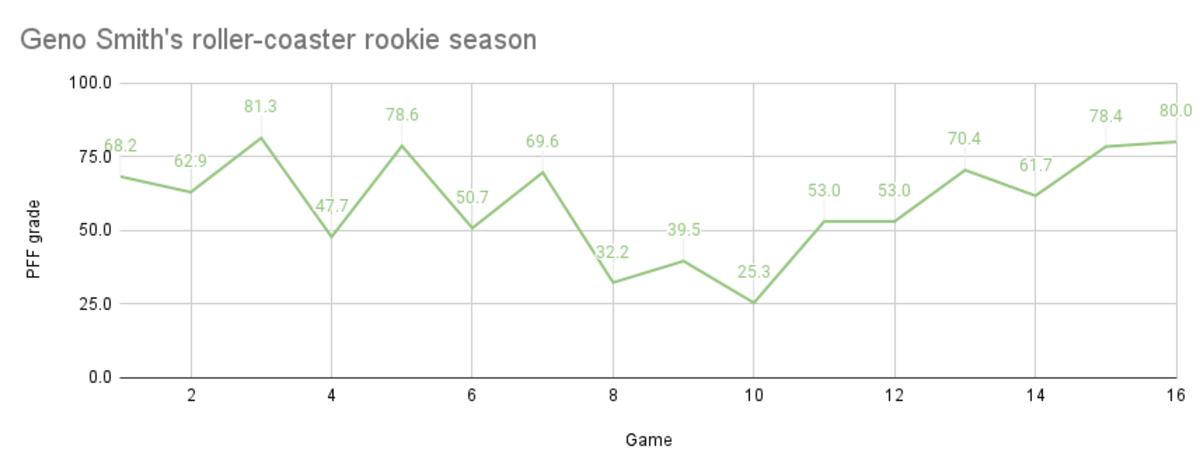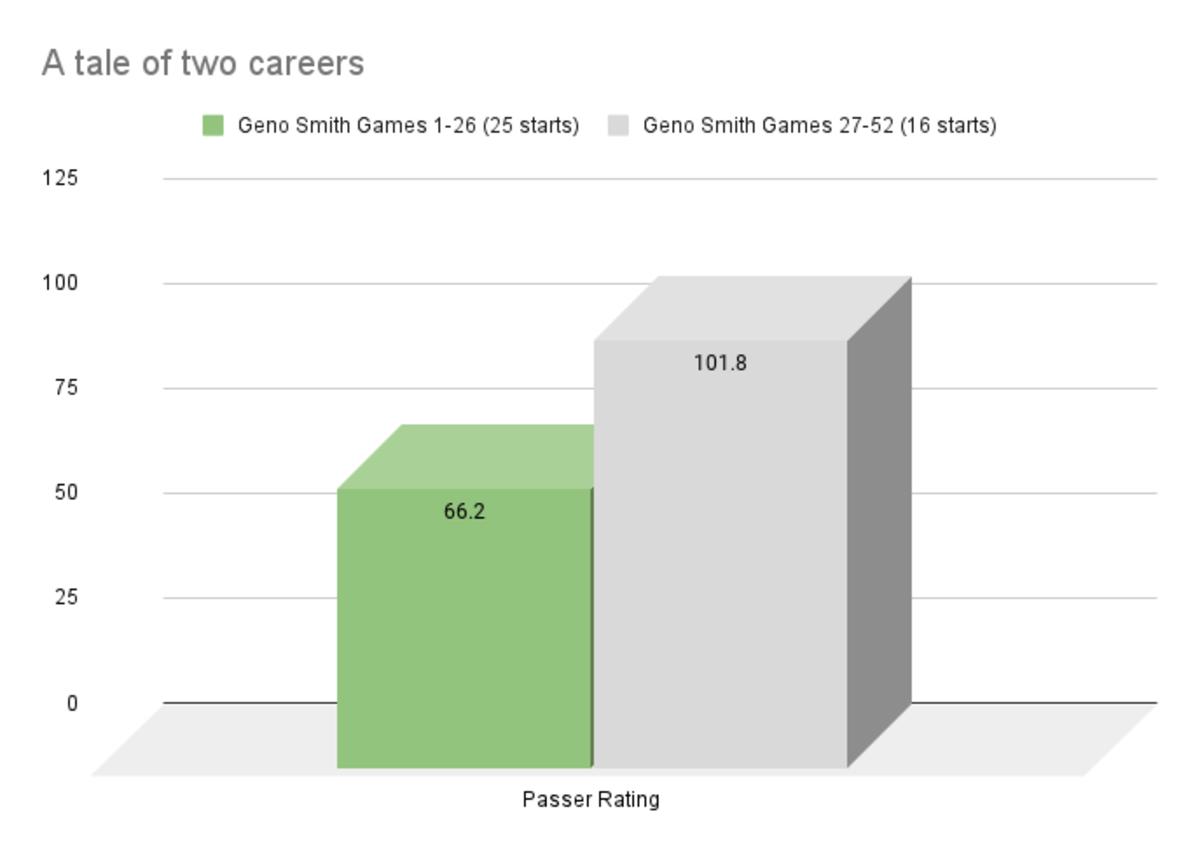NFLytics: Should we have seen Geno Smith's rise coming?

Welcome everyone to NFLytics, Purple Insider’s new weekly feature that puts a storyline from around the NFL at large underneath the analytics microscope. Our first edition focuses on Geno Smith’s remarkable start to the season. Let’s dive right in…
Through seven weeks of the NFL season, three of the MVP frontrunners are Josh Allen, Patrick Mahomes and Geno Smith.
One of those things is not like the others.
When the Seattle Seahawks traded Russell Wilson to the Denver Broncos, one piece of the return was Drew Lock, a 2019 second-round pick from Missouri who seemed to be the perfect project quarterback for a team in transition. After the deal was completed, Pete Carroll heaped praise on Lock, saying he would have been the top QB taken in the 2022 draft.
There were groans when Lock didn’t win the job out of training camp. Why are the Seahawks playing a 32-year-old veteran rather than the younger guy with upside? Turns out the long-time backup was the one who unexpectedly had a high ceiling. At least it was unexpected for everyone outside of Smith, who said after a win, “They wrote me off, I didn’t write back.” It’s surprising Drake hasn’t made a song out of those lyrics yet.
Anyway, prior to the start of 2022, Smith, who was taken in the second round of the 2013 draft by the New York Jets, won just 13 of his 34 career starts and had more interceptions than touchdowns. He previously averaged just 153 yards per game passing and got sacked on an astronomical 8.6% of drop-backs. Out of 52 quarterbacks to throw more than 1,000 passes between 2013 and 2021, Smith ranked 51st in yards per attempt when adjusted for sacks and interceptions.
This year Smith has completed nearly 74% of his throws, picked up 244 yards passing per game, tossed 11 touchdowns to just three interceptions, registered the third highest passer rating and the NFL and ranks as the third best PFF-graded quarterback behind Allen and Mahomes.
The season is far from over and we have certainly seen hot stretches from backup quarterbacks in the recent past — just ask Nick Foles who came off the bench to beat Tom Brady in the 2017 Super Bowl — but if Smith continues his high level of play he will be in unique company with very few QBs historically having careers kickstarted in their 30s.
Is it really as shocking as it seems? Was there any evidence in the numbers that a player once considered a bust would emerge as a star nearly a decade later?
The benefit of hindsight certainly helps us find some.
At West Virginia Smith was a prolific passer, leading his conference in Passing Efficiency Rating for three straight seasons. College stats don’t always translate to the NFL but Smith’s college career PER was very impressive — higher than Justin Herbert, Patrick Mahomes and Derek Carr. Add that with his NFL Combine performance, which the website Relative Athletic Scores placed in the 95th percentile among quarterbacks, and you have the makings of a top QB in the draft.
NFLNextGEN stats recently released a metric to score the quality of a prospect based on their athleticism and production. Their grades on a 1-100 scale gave Smith a 91, which was just over the bar for an “elite” prospect. For context, Mahomes scored a 98.
The biggest concern was that his numbers were artificially inflated by West Virginia’s spread offense but Smith had the arm strength to meet NFL qualifications, throwing the ball 55 mph at the Combine, according to Ourlads. That’s the same as Mahomes. (Josh Allen threw it an absurd 62 mph, by the way).
Of course, Smith wasn’t at the same level as Mahomes as a prospect and there haven’t been many success stories outside of the first round with QBs in recent years. Since 2013 only Jimmy Garoppolo, Derek Carr and Jalen Hurts have come out of the second or third rounds and become above average starters. Dak Prescott is the only QB past the third round to succeed in that span.
From his college numbers, athleticism and draft status, it’s clear that Smith had the ability to meet thresholds of good NFL quarterbacks but his profile wasn’t so stunningly excellent that he was considered a can’t-miss player who shockingly went sideways like, say, JaMarcus Russell or Ryan Leaf. Put another way: His failure to succeed as a starter didn’t raise many questions based on his college career and draft status.
What about his time with the Jets?
Smith’s rookie year was so volatile that his performance would make Jameis Winston blush. He finished the season tied for 10th with Eli Manning and Matthew Stafford in PFF’s “big-time throw” percentage but led the NFL in “turnover-worthy play” percentage.

There was somewhat of a turn in Smith’s play at one point with New York. Arbitrary endpoints are usually considered a no-no in statistical analysis but there is something interesting in Smith’s game log: If we go back to the final four games of his 2014 season and cobble together his various fill-ins as a backup between 2015 and 2021 we get 19 appearances (nine starts), 64.6% completion, 15 touchdowns, five interceptions, 7.7 yards per attempt and a 97.5 rating. Add in this year and his rating is over 100 since December 2014. Starter-level stats.
It would have been easy for the Jets to ignore a decent end to the 2014 season because the start to his sophomore year was so rough. Smith went eight straight starts without a win and by Week 13 of 2014 he had a 65.8 rating and one game graded by PFF over 65.0 (a 70 grade is about an average performance). In the final four weeks, however, he posted nine big-time throws and just three turnover-worthy plays and had two games graded above 75.0.
In the subsequent five seasons, Smith only threw 101 passes and there was nothing spectacular within that sample. He threw four touchdowns, four interceptions and had a decent showing in one start for the Giants in 2017.
Last season when Wilson went down with a thumb injury Smith filled in admirably. On 95 attempts, he completed 68.4%, threw five touchdowns to one interception, gained 7.4 yards per attempt and finished with a PFF grade (73.9) that would have placed him between Jimmy Garoppolo and Matt Ryan if he repeated it for a full season.

Still there wasn’t much indication of Mahomesian play on the way. By ESPN’s 1-100 QBR metric, which takes into account game situation, Smith only posted a 45.8 in 2021, which put him in the territory of Baker Mayfield and Taylor Heinicke.
So with only flashes of high-end play over the bigger sample size, it would have been difficult to forecast an age-32 breakout season. That doesn’t mean it was impossible.
Again, we get to involve our old friend hindsight here but there are some circumstances in Seattle that are playing heavily in Smith’s favor that maybe we could have seen coming.
For starters, the Seahawks have a phenomenal running game, which ranks second in the NFL in yards per carry (5.5). That has been driven by a star rookie running back in Kenneth Walker. Smith is crushing all of the situations where his team has the option to run or pass. He has a 105.0 rating on first-and-10, 130.0 on second-and-medium and 126.1 on any down with fewer than four yards to go.
That ties into the play-action game. Smith’s completion percentage when using play-action jumps by 12.0%, the third highest differential in the NFL this year and the Seahawks are using play-action on the 9th highest percentage of plays (per PFF). Normally play-action has a significant impact on the success of a QB. Last year 23 of 27 QBs with at least 100 play-action drop-backs saw an increase in yards per attempt and 19 improved completion percentage when using a play fake.
In a year where supporting casts may be having more impact than ever because of the sheer number of middling QBs, Smith has some nice toys around him. Tyler Lockett has caught 80.4% of passes in his direction and DK Metcalf averages 13.5 yards per attempt. Speedster Marquise Goodwin has added a deep threat with 10 catches for 146 yards. The Seattle offensive line has been competent, ranking 15th in pass blocking by PFF, which is up from 25th last year.
Schedule matters, too. Smith has faced four of the bottom 10 defenses in terms of passer rating allowed. Seattle produced just 24 points against Denver and San Francisco and dropped 45 on the lowly Lions.
That doesn’t mean Smith’s fall is on the way. Over the last two decades we have seen quarterbacks ascend in their 30s, whether it’s Trent Green going to his first Pro Bowl at age 33 or Jeff Garcia coming out of the CFL to lead the 49ers to a 12-4 season in 2001 or Rich Gannon winning MVP in 2000 after acting as QB2 from 1993 to 1998.
You have to go back that far to find shocking rises to power from 30-plus QBs. The long-time backup-turned-star-QB is a motif rarely seen in today’s game. The NFL tends to move on from quarterbacks quickly and it’s rare to see a “bust” get another shot after many years on the bench. And it’s hard to blame them. For every Smith, there’s lots of Mitch Trubiskys, Sam Darnolds, Andy Daltons and Jacoby Brissetts who are just filling space until someone else arrives. But from a statistical perspective two seasons might not be enough football to be certain about a QB’s future. The fact that Alex Smith and Matthew Stafford threw interceptions at the same rate as Geno and Eli Manning’s QB rating was lower through two years than Geno’s is enough to wonder if they weren’t top picks in the entire draft whether they would have been tossed to the curb instead of putting together very good NFL careers.
Will it make teams think about giving journeyman backups a chance rather than always looking to the draft because of Geno Smith? Maybe. There is one advantage, albeit a short-term edge: Price. Smith is making $3.5 million on the cap this year, which ranks 36th among quarterbacks. His 2022 season might result in the Seahawks using the franchise tag (around $30 million) and then the equation changes.
So we will keep an eye on Smith and see whether he’s the next Rich Gannon or a flash of favorable circumstances like Foles was in 2017.
As far as whether his stunning start was foreseeable: Not really. But the things we don’t expect are what make football great and Geno Smith is at the top of the list of great stories in the NFL this season.
